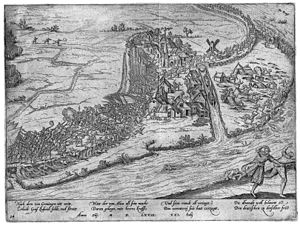Battle of Jemgum (1568)
| date | July 21, 1568 |
|---|---|
| place | Jemgum , East Frisia |
| output | Victory of Spain |
| Parties to the conflict | |
|---|---|
| Commander | |
| Troop strength | |
| 10,000 infantrymen, 2,000 cavalrymen, 16 cannons | 12,000 infantrymen, 3,000 cavalrymen |
| losses | |
|
7,000 dead |
300 dead |
Western Europe
Oosterweel - Dahlen - Heiligerlee - Jemgum - Jodoigne - Le Quesnoy - Brielle - Mons - Goes - 1. Mechelen - Naarden - Middelburg - Haarlem - Alkmaar - Geertruidenberg - Leiden - Delft - Valkenburg - Mooker Heide - Schoonhoven - Zierikzee - 1. Antwerp - Gembloux - Rijmenam - 1. Deventer - Borgerhout - 1. Maastricht - 2. Mechelen - 1. Steenwijk - Kollum - 1. Breda - Noordhorn - Niezijl - Lochem - Lier - Eindhoven - Steenbergen - Ghent - Aalst - 2. Antwerp - IJsseloord - Empel - Boksum - 1. Grave - 1. Venlo - Axel - Neuss - 1. Rheinberg - Zutphen - 1. Sluis - 1. Bergen op Zoom - 2. Geertruidenberg - 2. Breda - 2. Zutphen - 2. Deventer - Delfzijl - Knodsenburg - 1. Hulst - Nijmegen - Rouen - Caudebec - 2. Steenwijk - 1. Coevorden - 3. Geertruidenberg - 2. Coevorden - Groningen - Huy - 1. Groenlo - Lippe - Calais - 2. Hulst - Turnhout - 2. Rheinberg - 1. Moers - 2. Groenlo - Bredevoort - Enschede - Ootmarsum - 1. Oldenzaal - 1. Lingen - 1. Schenckenschans - Zaltbommel - Rees - San Andreas - Nieuwpoort - 3. Rheinberg - Ostend - 1. 's-Hertogenbosch - 2. Grave - Hoogstraten - 3. Sluis
Twelve Years Peace
2. Lingen - 3. Groenlo - Aachen - Jülich - 2. Bergen-op-Zoom - Fleurus - 3. Breda - 2. Oldenzaal - 4. Groenlo - 2. 's-Hertogenbosch - Slaak - 2. Maastricht - Leuven - 2. Schenkenschans - 4. Breda - 2. Venlo - Kallo - 3. Hulst
European waters
Vlissingen - Borsele - Haarlemmermeer - Zuiderzee - Scheldt - Lillo - Ponta Delgada - Bayona Islands - Gulf of Almería - 1st Cadiz - Azores - Strait of Dover - 2nd Sluis - 1st Cape St. Vincent - 1st Gibraltar - 2nd Gibraltar - 2nd Cadiz - Lizard Point - Dunkirk - Calais - Downs - 2nd Cape St. Vincent - 2nd St. Martin
America
Bahia - Matanzas - St. Martin - San Juan - Abrolhos - Pernambuco - South Chile
East Indies
Playa Honda - 1st San Salvador - 2nd San Salvador - La Naval de Manila - Puerto de Cavite
The second Battle of Jemgum ( Dutch Slag bij Jemmingen ) was fought in 1568 as part of the Dutch War of Independence . After the battle of Heiligerlee , the Geusen under Ludwig von Nassau could not take the city of Groningen . Ludwig was pursued by Fernando Álvarez de Toledo, Duke of Alba , as far as East Friesland and ultimately defeated at Jemgum on July 21, 1568.
course
The Spanish army consisted of 12,000 infantrymen (4 tercios), a cavalry with a strength of 3,000 men and a few cannons . Ludwig von Nassau faced them with an infantry of 10,000 men (two groups), a small cavalry and 16 cannons. After three hours of trench warfare, Ludwig's army left their trenches and advanced. Intimidated by the Spanish cavalry and musket fire , the rebels withdrew towards the Ems . The Duke of Alba lost 100 men, while Ludwig von Nassau lost 7,000. Duke Alba had all wounded enemies killed. Ludwig himself escaped across the Ems.
The fact that the rebellious Dutch fled to East Frisia had dire consequences for the county. Alba's mercenary army looted, pillaged and raped for three days in the Rheiderland . Only Alba's sons prevented the cruel duke from having all the women and children from Jemgum who had fled to a local monastery burned after the battle. On the occasion of his triumph he had a monument to victory erected in the courtyard of the citadel of Antwerp , which was destroyed soon after his recall. The Alba-Huus , where he is said to have quartered himself, still stands in Jemgum today .
Legacies
While the walls of earlier fortifications have not been preserved in the area, human skulls were found in the vicinity of Jemgum as archaeological remains of the battle. In 1928 and 1930 three skulls were found at Nendorp. In the local history museum in Weener there are 7 skulls and one partial skull that were found in a mass grave near Nendorp. Since it was found several kilometers north of Jemgum on the western bank of the Ems, it is assumed that the dead were Dutch soldiers who were slain here by Spanish horsemen on the run. A follow-up investigation at the site found two coins from the 15th and 16th centuries. The younger silver coin can be dated to 1562. Closer examination of a skull revealed that the injuries were caused by a war flail. Other traces on the skull came from swords and a cutting weapon. In addition, the dead person was beheaded. Some of the skulls found show injuries from morning stars .
See also
literature
- Andreas Hüser: The battle near Jemgum. Archaeological finds from the Rheiderland in: Archeology in Lower Saxony Vol. 17. Oldenburg 2014, pp. 102-106
Individual evidence
- ↑ Martin Espenhorst (ed.) Ignorance and misunderstandings in the premodern peace process . Vandenhoeck & Ruprecht 2013 ISBN 978-3-525-10127-8 p. 53ff (still picture Duke Albas)


